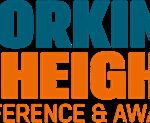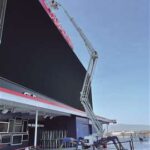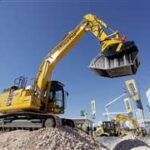What Is a Scissor Lift?
Scissor lifts are commonly used on construction and industrial sites to lift workers and equipment vertically. They help move personnel and materials up and down with ease. While they serve similar functions to aerial lifts, they aren’t classified as aerial lifts by OSHA. Instead, scissor lifts are considered mobile scaffolds, which means they follow different guidelines when it comes to platform height, capacity, and safe use.
How Much Does a Scissor Lift Weigh?
The weight of a scissor lift varies greatly depending on the model and type. For example, electric scissor lifts are generally lighter than their heavy-duty counterparts, like rough terrain scissor lifts.
Scissor lift weights range anywhere from 1,600 lbs to 17,000 lbs. Smaller models, like the 15-foot Genie Runabout, weigh as little as 1,600 lbs, whereas larger models, like a 40-foot scissor lift, can weigh anywhere between 7,300 lbs and 17,000 lbs. The bigger the lift, the heavier it will be.
Why Does Scissor Lift Weight Matter?
The weight of a scissor lift matters more than you might think. It affects several key factors:
-
Transportation: Lighter scissor lifts are easier to move around. For example, a single truck can carry up to 22 lightweight Hy-Brid lifts—about 8 more than if it were hauling traditional lifts.
-
Load Capacity and Weight Limits: Heavier lifts tend to have higher platform capacities and weight limits, meaning they can carry more equipment and personnel.
-
Number of Workers on the Ground: A lighter scissor lift allows for more workers to be on the ground before reaching the lift’s maximum load capacity, which can make a big difference on busy job sites.
How to Find the Weight of Your Scissor Lift
To figure out how much your scissor lift weighs, check the equipment’s spec sheet. Rental companies like BigRentz provide detailed specs, including lift weight, so you can make an informed decision.
And, as always, be sure to read the operation manual before using any heavy equipment to ensure you’re following safety protocols.
Popular Scissor Lift Brands and Models
Although scissor lifts serve the same basic purpose, they come in different models, types, and sizes. Here are some popular scissor lift manufacturers:
-
JLG: JLG offers both electric and engine-powered scissor lifts. Their electric models are known for zero emissions and quiet operation, making them ideal for indoor use. Engine-powered models are larger, heavier, and offer higher load capacities and wider platforms.
-
Genie: Genie primarily manufactures electric scissor lifts, which are great for tight spaces where maneuverability is key. They’re quieter and more maneuverable, making them a solid choice for indoor projects.
-
Skyjack: Skyjack offers a variety of lifts, including scissor lifts, forklifts, boom lifts, and telehandlers. Their versatile product range is designed to meet the needs of various job sites and tasks.
Lightweight, Mid-Range, and Heavy-Duty Scissor Lifts
-
Lightweight Scissor Lifts: Models like the Hy-Brid PS-1930 are ideal for jobs in stable, even terrain. These lifts are typically powered by electricity, so they’re zero-emission and suitable for indoor use. They’re quieter, portable, and easy to navigate, but they also have lower weight capacities and are best for shorter tasks.
-
Mid-Range Scissor Lifts: A model like the Genie GS-2032 is heavier but offers more versatility. These lifts work well both indoors and outdoors, with increased platform capacities and greater working heights.
-
Heavy-Duty Scissor Lifts: Rough terrain models, like the Skyjack SJ6826/32, are designed for tough outdoor environments. These lifts often use gas as their power source, which gives them a longer run time than electric models. While they’re heavier, they can carry larger loads and are built for more demanding jobs.
Scissor Lift Uses
Scissor lifts are mainly used in construction for tasks at height. They provide a safer and more efficient alternative to ladders or scaffolding. Some of the most common uses include:
-
Lifting and Supporting Workers: Scissor lifts can carry workers to the necessary heights safely, depending on their platform capacity.
-
Transporting Materials: In addition to lifting workers, scissor lifts can transport materials to different levels, helping move heavy equipment and supplies that would otherwise be difficult to lift.
-
High-Elevation Tasks: Scissor lifts make it much easier to complete tasks that require working at height, whether it’s construction, installation, or maintenance.
Scissor lifts are not limited to construction. They’re also widely used in industries like:
-
Landscaping: Helping landscapers reach tall trees, install lighting, or transport heavy tools to different heights.
-
Business Operations: Used for tasks like changing lights, hanging banners, retrieving inventory, and performing repairs in stores or warehouses.
-
Warehouses: Scissor lifts help warehouse workers pick and sort inventory from high shelves, or transport goods to elevated areas.
How to Choose the Right Scissor Lift
Choosing the right scissor lift for your job depends on several factors:
-
Project Budget: Rental costs for scissor lifts vary greatly, depending on the model and how long you need it. A bigger lift with more capacity will naturally be more expensive.
-
Job Site Conditions: Consider the terrain. For indoor, flat, and stable surfaces, a lightweight electric lift will work well. For rougher, outdoor environments, a diesel-powered, heavy-duty lift is more suitable.
-
Platform Size and Weight Requirements: Make sure the lift you choose can handle the amount of weight you need to lift, whether it’s heavy materials or a larger team of workers.
-
Lift Height and Stability: Ensure the lift has the necessary vertical reach to accomplish your tasks while maintaining stability at height.
With so many options available, finding the right scissor lift can feel overwhelming. But keeping these key factors in mind will help you narrow down your options and find the best lift for the job. For more rental info, check out our FAQs and rental guide!




